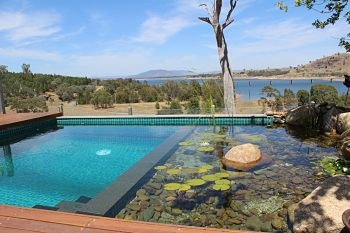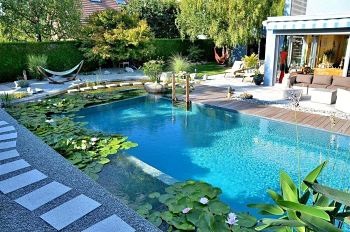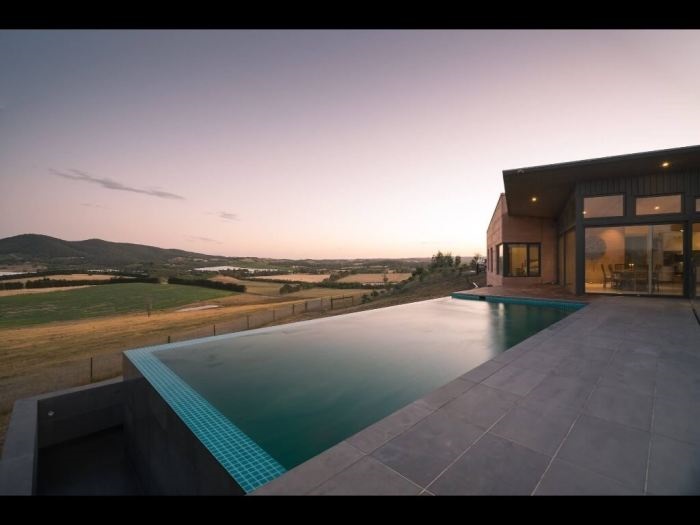natural pools better homes and gardens
The pools in this video are equipped with gartenART biofilter technology and built in collaboration with gartenART Australia. They were variously designed and constructed by gartenART Australia, Landforms, Simon Lloyd and Panda Pools & Spas.
A quiet revolution made a splash in Europe in the 1980s: the development of a chlorine-free pool that harnesses the power of nature to cleanse the water. These so-called natural swimming pools – also known as swimming ponds and bio pools – took off and now number in the tens of thousands. They're still a niche product here, but they could be the next big thing in Australian backyards.
There are 120 natural pools in Australia, estimates Ralf Schmiel, co-founder of the International Organization for Natural Bathing Waters (IOB), but numbers have increased considerably in the last three years.
While natural pools originated in Europe, they can easily be adapted to the Australian climate as our water is very soft and low in nutrients, making it better suited to natural pools, says Annika Kvist of Natural Swimming Pools Australia.
"The best water I have ever worked with is in Australia," adds Schmiel, whose company gartenART Australia builds natural pools around the country.
What are natural pools like to swim in?
Picture this: you're swimming in a beautiful freshwater lake. The water is clear and refreshing. Dragonflies dance in the reeds and native birds swoop down for a drink. You feel rejuvenated and connected to nature. You don't need to shower afterwards: your hair is soft from the water and your skin feels clean, but not dry or itchy.
Natural pools make this wild swimming experience possible in a suburban backyard. These pools harness biological processes to purify the water – no chemicals necessary.
What's with all the plants?
Classical natural pools can resemble naturally-occurring ponds, with a swimming area surrounded by a regeneration zone (or biozone) – shallow gravel beds planted with reeds, water lilies and other aquatic plants – which cleans the water as it pumps through. But they can also be more formal, with a sparkling swimming area and biozone off to the side.

A natural pool in Talgarno, Victoria. The regeneration zone is set off to the side of the swimming area. Image credit: Natural Swimming Pools Australia.

A natural pool in France. The biozone surrounds the central swimming area. Image credit: BIOTOP. Copyright: © natural-pool.com. (Please note: this pool is not fenced to Australian standards.)
How do natural swimming pools keep the water clean?
Forget everything you know about how pools work: natural pools operate in a completely different way.
Think of conventional swimming pools as $1-a-loaf supermarket bread, and natural pools as organic, artisan sourdough: they both make a sandwich, but the way they're made and how they make you feel can be very different.
Chlorine sanitises conventional pools by killing virtually everything (except swimmers). Natural pools are often described as 'alive' since they're literally teeming with life. Besides plants, the water is full of friendly bacteria and microscopic creatures called zooplankton. These all work to purify the water and keep algae at bay.
For algae to grow, it needs nutrients. The bacteria, plants and zooplankton in natural pools use up these nutrients so there's none left for the algae to feed on. The zooplankton also eat algae cells and pathogens, keeping them under control.
The pools in this video (except still image) are equipped with gartenART biofilter technology and built in collaboration with gartenART Australia. They were variously designed and constructed by gartenART Australia, Landforms, Simon Lloyd and Panda Pools & Spas.
What if I don't have space?
Pools with biozones have larger footprints than conventional pools, but even city dwellers with tiny backyards can have a natural pool by replacing the biozone with a compact biofilter. These don't contain plants, but do harness the same friendly bacteria to naturally cleanse the pool.
Pools with biofilters are gaining popularity, says Kvist, as they offer a low-maintenance solution with all the benefits of a natural pool.

This natural pool near Melbourne uses a biofilter instead of plants to clean the water. Image credit: gartenART Australia.
How much does a natural swimming pool cost?
Remember our bread analogy? You'd expect to pay more for an artisan sourdough than bagged supermarket bread, right? It's the same with natural pools. Not only are you potentially paying extra for the biozone excavation, you're also paying for specialised equipment and expertise.
But while up-front costs are higher, running costs are lower: you're not buying chemicals, and natural pools use smaller, more energy-efficient pumps than traditional pools.
Natural swimming pools compared
What's the cost for a new build?
Above-ground pool: $10,000+
In-ground pool: $35,000+ (fibreglass) or $55,000+ (concrete)
Natural pool: $60,000+
Swimming pool running costs per year
Natural pool
Energy cost per year (approx.): $350
Chlorinated pool
Energy cost per year (approx.): $500
Chemical cost per year (approx.): $500
Data provided by SPASA Australia and gartenART Australia.
Are they as safe as chlorine pools?
Natural pools are a relatively new kid on the block. As with many new things, the science is still catching up – there isn't 100-plus years of research to draw on like there is with chlorinated pools.
"We don't really know a great deal about how favourable or hostile a natural swimming pool biome is to human pathogens – we are still learning about this," says associate professor Susan Petterson of the Griffith University School of Medicine, who was a key stakeholder in a risk assessment of a public natural pool in Edmonton, Canada.
"The biggest question is around the viruses that can be present in very high numbers and [are] quite resilient to natural processes. It's therefore difficult to comment on whether the internal disinfection of a natural pool would be more or less effective than a conventional chlorine pool, but I would lean towards saying less because we just don't have the data yet."
As with chlorinated pools, good swimming hygiene practices like showering before swimming, not swimming for two weeks after diarrhoea and minimising the chance of 'accidental faecal releases' (that's science-talk for someone accidentally pooping in the pool) can help minimise pathogen risks.
Safety in public pools
More than 130 public natural swimming pools have been built in Europe and the UK, and a handful in North America – all regions with strict policies on public swimming pool safety. These pools are used by thousands of swimmers each day in summer and need to meet rigorous guidelines for bacteria and nutrient levels.
There have been a few hiccups along the way – a viral meningitis outbreak in Germany was tenuously linked to an overcrowded natural pool (but was never proven), and the Webber Natural Swimming Pool in Minneapolis closed several times due to elevated bacteria levels. But public natural pools have been overwhelmingly incident-free since the first one opened in 1998, says Stefan Bruns, former Managing Director of the International Organization for Natural Bathing Waters (IOB).
Chlorine has a well-earned reputation as a stone-cold killer, but it actually has little to no effect on nasty pathogens like cryptosporidium and giardia, which cause gastroenteritis. There were 149 crypto cases in NSW in December 2016 alone, and the biggest crypto outbreak in NSW was in 1998, with more than 1000 reported cases linked to chlorinated swimming pools.
Can I convert my existing chlorine pool to a natural pool?
Biofilters are generally the go-to if you want to convert an existing pool. It's an easy process, Kvist says: all you need to do is install it next to the pool and drill a few extra pipes. And it will cost anywhere from $5000 for a DIY job through to $30,000+. Internal conversions, where the biofilter is installed inside the existing pool shell, are also possible.
Do natural pools need more maintenance than chlorine pools?
Natural pools without plants require the same amount or even less maintenance than a traditional pool, experts claim. You need to empty the skimmer and backwash the filter, as with a traditional pool, while a robotic cleaner takes care of cleaning the swimming area. You may need to brush edges and steps in the swimming area to remove biofilm (a layer of friendly bacteria), which can make them slippery.
Biozones require more work: you need to remove dead leaves in spring and autumn and sometimes cut the plants back, just like with land plants. Kvist likens it to weeding a garden. "It's a matter of just getting rid of dead foliage in the pool. It's quite therapeutic, if you like doing that," she says.
Can you heat a natural pool?
Yes. Natural pools can be heated to around 26°C without any negative effects on the ecosystem. Some builders claim they can heat pools up to 32°C.
Do they attract mosquitoes and other critters?
Mosquitoes only breed in stagnant, shallow water. In a natural pool, the pump runs 24/7 so the constantly moving water is unsuitable for mosquito breeding. Insects in the biozone also clean up mosquitoes and their larvae.
Natural pools do attract more wildlife than chlorinated pools: birds and koalas drink from Kvist's pool, and she's noticed an increase in dragonfly numbers since installing it. But she says natural pools don't attract unwanted creatures (snakes, spiders and the like) any more than conventional pools do. "That's just a part of living in Australia."
What's so great about natural pools?
While you may love how natural pools look, enthusiasts say the key selling point – how the water feels – is difficult to convey. It's variously described as "alive", "refreshing" and "rejuvenating". It's this intangible quality that wins most people over.
"It sounds a bit strange, but it feels very refreshing. It feels different to chlorinated water," says Kvist.
"Everyone who swims in a natural pool says, 'Wow, what beautiful water,'" adds Schmiel. "And that's something you cannot describe. You cannot put it in a photo. It's only something you can experience."
natural pools better homes and gardens
Source: https://www.choice.com.au/outdoor/pools/cleaning-and-maintenance/articles/natural-swimming-pools
Posted by: charbonneauplacts.blogspot.com

0 Response to "natural pools better homes and gardens"
Post a Comment